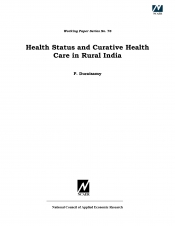Health Status and Curative Health Care in Rural India
P. Duraisamy
December 2001
In this study, an attempt has been made to examine the determinants of health status and curative health care of children, adults and the elderly in rural India using the NCAER-HDI (Human Development Indicator) national-level survey data for 1994. Health status is defined in terms of illness prevalence rate and functional disability based measures. Descriptive evidence on the measures of morbidity and choice of health care shows that there is considerable variation across the socio-economic and demographic attributes of individuals and households. The household demand framework is used to specify the reduced-form health status and curative care functions. These functions are estimated using maximum likelihood probit, tobit and multinomial logit methods. The results indicate a U-shaped relationship between age and morbidity. Both education and income exert a negative impact on morbidity measures used in this study. An interesting result is the significant negative effect of smoking on adult and elderly morbidity. Morbidity is found to be higher among the scheduled caste and scheduled tribe population. The study also sheds light on the effect of other household and village infrastructure variables on the measures of morbidity. The estimates of the multinomial discrete choice model of curative health care show that the real choice in rural India is between private health care and other types of health-care facilities. Primary-level education, household income, and village-level infrastructure and amenities are found to increase the probability of choosing private health care over any other type of facility.
Human Development and Data Innovation







